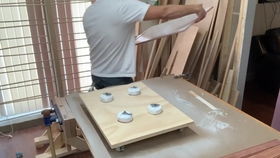Paint Without Sanding Furniture: A Comprehensive Guide
Transforming the look of your furniture without the hassle of sanding can be a game-changer. Whether you’re looking to refresh your home decor or simply want to avoid the time-consuming task of sanding, this guide will walk you through the process of painting furniture without sanding. Let’s dive in!
Understanding the Process

Painting furniture without sanding involves several steps, each crucial to the success of the project. Here’s a breakdown of what you need to know:
| Step | Description |
|---|---|
| Preparation | Clean the furniture thoroughly and remove any hardware. |
| Surface Treatment | Apply a degreaser or primer to ensure the paint adheres properly. |
| Painting | Choose the right paint and apply it using the appropriate technique. |
| Drying and Curing | Allow the paint to dry completely and cure according to the manufacturer’s instructions. |
Now that you have a general understanding of the process, let’s delve into each step in more detail.
Preparation

Before you start painting, it’s essential to prepare your furniture. Begin by cleaning the surface thoroughly to remove any dirt, dust, or grease. Use a damp cloth to wipe down the furniture and then let it dry completely. If there are any loose or peeling paint spots, gently sand them down to ensure a smooth surface. Next, remove any hardware, such as handles or knobs, to make painting easier.
Surface Treatment

Once your furniture is clean and dry, it’s time to apply a degreaser or primer. This step is crucial for ensuring that the paint adheres properly to the surface. A degreaser will remove any remaining grease or dirt, while a primer will help the paint bond to the furniture. Choose a primer specifically designed for your type of furniture, such as oil-based or water-based, and apply it according to the manufacturer’s instructions.
Painting
Choosing the right paint is essential for achieving a beautiful finish. When painting furniture without sanding, it’s best to use a high-quality, oil-based paint. Oil-based paints are more forgiving and can cover imperfections better than water-based paints. Here are some tips for painting your furniture:
- Use a brush or roller to apply the paint. A brush is ideal for small areas, while a roller is great for larger surfaces.
- Apply thin, even coats of paint. Too much paint can cause drips and runs.
- Let each coat dry completely before applying the next one.
- Consider using a paint sprayer for a more even and professional finish.
Drying and Curing
After applying the final coat of paint, let the furniture dry completely. The drying time will vary depending on the type of paint and the environmental conditions. Once the paint is dry to the touch, it’s time to cure it. Curing is the process of allowing the paint to harden and reach its full strength. This can take several days, so be patient. Once the paint is cured, you can reattach any hardware and enjoy your freshly painted furniture.
Additional Tips
Here are some additional tips to help you achieve the best results when painting furniture without sanding:
- Use a high-quality paintbrush or roller for a smooth finish.
- Apply a thin, even coat of paint to avoid drips and runs.
- Let each coat dry completely before applying the next one.
- Consider using a paint sprayer for a more even and professional finish.
- Protect your furniture from scratches and dings by applying a clear coat of polyurethane after the paint is cured.
Painting furniture without sanding can be a rewarding and cost-effective way to refresh your home decor. By following these steps and tips, you can achieve a beautiful, professional-looking finish without the hassle of sanding. Happy painting!
